Antibody data
- Antibody Data
- Antigen structure
- References [36]
- Comments [0]
- Validations
- Western blot [2]
- Immunocytochemistry [4]
- Immunohistochemistry [1]
- Flow cytometry [2]
Submit
Validation data
Reference
Comment
Report error
- Product number
- MA1-19041 - Provider product page

- Provider
- Invitrogen Antibodies
- Product name
- Cytokeratin 18 Monoclonal Antibody (DC-10)
- Antibody type
- Monoclonal
- Antigen
- Other
- Description
- This antibody reacts with cytokeratin 18 (45 kDa). Cytokeratins are members of intermediate filaments subfamily of intracellular proteins, represented in epithelial tissues. This antibody will not cross-react with porcine, mouse, rat, hamster, bovine, canine or sheep.
- Reactivity
- Human
- Host
- Mouse
- Isotype
- IgG
- Antibody clone number
- DC-10
- Vial size
- 100 μg
- Concentration
- 1 mg/mL
- Storage
- 4°C, do not freeze
Submitted references Casein kinase 1 is recruited to nuclear speckles by FAM83H and SON.
Vitamin D and androgen receptor-targeted therapy for triple-negative breast cancer.
FAM83H and casein kinase I regulate the organization of the keratin cytoskeleton and formation of desmosomes.
Modelling breast cancer requires identification and correction of a critical cell lineage-dependent transduction bias.
Alterations of canalicular ATP-binding cassette transporter expression in drug-induced liver injury.
A novel mechanism of keratin cytoskeleton organization through casein kinase Iα and FAM83H in colorectal cancer.
Glucose and SIRT2 reciprocally mediate the regulation of keratin 8 by lysine acetylation.
Malignant transformation of adenomyoepithelioma of the breast by a monophasic population: a report of two cases and review of literature.
Expression of KRT7 and WT1 differentiates precursor lesions of Wilms' tumours from those of papillary renal cell tumours and mucinous tubular and spindle cell carcinomas.
Directed differentiation of human embryonic stem cells to epidermal progenitors.
Giant clear cell hidradenoma of the knee.
Cytoskeletal keratin glycosylation protects epithelial tissue from injury.
Antagonistic roles of Notch and p63 in controlling mammary epithelial cell fates.
Endometrial profile of tamoxifen and low-dose estradiol combination therapy.
Imaging and analysis of 3D tumor spheroids enriched for a cancer stem cell phenotype.
Assessment of the tumorigenesis and drug susceptibility of three new canine mammary tumor cell lines.
Generation of hepatocyte-like cells from in vitro transdifferentiated human fetal pancreas.
Generation of hepatocyte-like cells from in vitro transdifferentiated human fetal pancreas.
Antigen expression of human eccrine sweat glands.
Long-term cultures of bone marrow-derived human mesenchymal stem cells frequently undergo spontaneous malignant transformation.
Frzb, a secreted Wnt antagonist, decreases growth and invasiveness of fibrosarcoma cells associated with inhibition of Met signaling.
Monitoring of epithelial cell caspase activation via detection of durable keratin fragment formation.
An immunohistochemical profile of giant cell carcinoma of the larynx.
Mammary gland development in early pubertal female macaques.
Cellular and molecular mechanisms of abnormal calcification following ischemia-reperfusion injury in human liver transplantation.
Analysis of keratin polypeptides 8 and 19 variants in inflammatory bowel disease.
Blocking Wnt/LRP5 signaling by a soluble receptor modulates the epithelial to mesenchymal transition and suppresses met and metalloproteinases in osteosarcoma Saos-2 cells.
Identification of 14-3-3sigma as a contributor to drug resistance in human breast cancer cells using functional proteomic analysis.
Bispecific and human disease-related anti-keratin rabbit monoclonal antibodies.
Protein phosphatase-2A associates with and dephosphorylates keratin 8 after hyposmotic stress in a site- and cell-specific manner.
Expression of Frzb/secreted Frizzled-related protein 3, a secreted Wnt antagonist, in human androgen-independent prostate cancer PC-3 cells suppresses tumor growth and cellular invasiveness.
Studying simple epithelial keratins in cells and tissues.
Cytokeratin expression in lichen amyloidosus and macular amyloidosis.
Keratin 8 and 18 hyperphosphorylation is a marker of progression of human liver disease.
Keratin mutation in transgenic mice predisposes to Fas but not TNF-induced apoptosis and massive liver injury.
Keratin 8 mutations in patients with cryptogenic liver disease.
Kuga T, Kume H, Adachi J, Kawasaki N, Shimizu M, Hoshino I, Matsubara H, Saito Y, Nakayama Y, Tomonaga T
Scientific reports 2016 Sep 29;6:34472
Scientific reports 2016 Sep 29;6:34472
Vitamin D and androgen receptor-targeted therapy for triple-negative breast cancer.
Thakkar A, Wang B, Picon-Ruiz M, Buchwald P, Ince TA
Breast cancer research and treatment 2016 May;157(1):77-90
Breast cancer research and treatment 2016 May;157(1):77-90
FAM83H and casein kinase I regulate the organization of the keratin cytoskeleton and formation of desmosomes.
Kuga T, Sasaki M, Mikami T, Miake Y, Adachi J, Shimizu M, Saito Y, Koura M, Takeda Y, Matsuda J, Tomonaga T, Nakayama Y
Scientific reports 2016 May 25;6:26557
Scientific reports 2016 May 25;6:26557
Modelling breast cancer requires identification and correction of a critical cell lineage-dependent transduction bias.
Hines WC, Yaswen P, Bissell MJ
Nature communications 2015 Apr 21;6:6927
Nature communications 2015 Apr 21;6:6927
Alterations of canalicular ATP-binding cassette transporter expression in drug-induced liver injury.
Zollner G, Thueringer A, Lackner C, Fickert P, Trauner M
Digestion 2014;90(2):81-8
Digestion 2014;90(2):81-8
A novel mechanism of keratin cytoskeleton organization through casein kinase Iα and FAM83H in colorectal cancer.
Kuga T, Kume H, Kawasaki N, Sato M, Adachi J, Shiromizu T, Hoshino I, Nishimori T, Matsubara H, Tomonaga T
Journal of cell science 2013 Oct 15;126(Pt 20):4721-31
Journal of cell science 2013 Oct 15;126(Pt 20):4721-31
Glucose and SIRT2 reciprocally mediate the regulation of keratin 8 by lysine acetylation.
Snider NT, Leonard JM, Kwan R, Griggs NW, Rui L, Omary MB
The Journal of cell biology 2013 Feb 4;200(3):241-7
The Journal of cell biology 2013 Feb 4;200(3):241-7
Malignant transformation of adenomyoepithelioma of the breast by a monophasic population: a report of two cases and review of literature.
Marian C, Boila A, Soanca D, Malau M, Podeanu DM, Resetkova E, Stolnicu S
APMIS : acta pathologica, microbiologica, et immunologica Scandinavica 2013 Apr;121(4):272-9
APMIS : acta pathologica, microbiologica, et immunologica Scandinavica 2013 Apr;121(4):272-9
Expression of KRT7 and WT1 differentiates precursor lesions of Wilms' tumours from those of papillary renal cell tumours and mucinous tubular and spindle cell carcinomas.
Szponar A, Kovacs G
Virchows Archiv : an international journal of pathology 2012 Apr;460(4):423-7
Virchows Archiv : an international journal of pathology 2012 Apr;460(4):423-7
Directed differentiation of human embryonic stem cells to epidermal progenitors.
Metallo CM, Ji L, de Pablo JJ, Palecek SP
Methods in molecular biology (Clifton, N.J.) 2010;585:83-92
Methods in molecular biology (Clifton, N.J.) 2010;585:83-92
Giant clear cell hidradenoma of the knee.
Yu G, Goodloe S Jr, D'Angelis CA, McGrath BE, Chen F
Journal of cutaneous pathology 2010 Sep;37(9):e37-41
Journal of cutaneous pathology 2010 Sep;37(9):e37-41
Cytoskeletal keratin glycosylation protects epithelial tissue from injury.
Ku NO, Toivola DM, Strnad P, Omary MB
Nature cell biology 2010 Sep;12(9):876-85
Nature cell biology 2010 Sep;12(9):876-85
Antagonistic roles of Notch and p63 in controlling mammary epithelial cell fates.
Yalcin-Ozuysal O, Fiche M, Guitierrez M, Wagner KU, Raffoul W, Brisken C
Cell death and differentiation 2010 Oct;17(10):1600-12
Cell death and differentiation 2010 Oct;17(10):1600-12
Endometrial profile of tamoxifen and low-dose estradiol combination therapy.
Wood CE, Kaplan JR, Fontenot MB, Williams JK, Cline JM
Clinical cancer research : an official journal of the American Association for Cancer Research 2010 Feb 1;16(3):946-56
Clinical cancer research : an official journal of the American Association for Cancer Research 2010 Feb 1;16(3):946-56
Imaging and analysis of 3D tumor spheroids enriched for a cancer stem cell phenotype.
Robertson FM, Ogasawara MA, Ye Z, Chu K, Pickei R, Debeb BG, Woodward WA, Hittelman WN, Cristofanilli M, Barsky SH
Journal of biomolecular screening 2010 Aug;15(7):820-9
Journal of biomolecular screening 2010 Aug;15(7):820-9
Assessment of the tumorigenesis and drug susceptibility of three new canine mammary tumor cell lines.
Chang CY, Chiou PP, Chen WJ, Li YH, Yiu JC, Cheng YH, Chen SD, Lin CT, Lai YS
Research in veterinary science 2010 Apr;88(2):285-93
Research in veterinary science 2010 Apr;88(2):285-93
Generation of hepatocyte-like cells from in vitro transdifferentiated human fetal pancreas.
Sumitran-Holgersson S, Nowak G, Thowfeequ S, Begum S, Joshi M, Jaksch M, Kjaeldgaard A, Jorns C, Ericzon BG, Tosh D
Cell transplantation 2009;18(2):183-93
Cell transplantation 2009;18(2):183-93
Generation of hepatocyte-like cells from in vitro transdifferentiated human fetal pancreas.
Sumitran-Holgersson S, Nowak G, Thowfeequ S, Begum S, Joshi M, Jaksch M, Kjaeldgaard A, Jorns C, Ericzon BG, Tosh D
Cell transplantation 2009;18(2):183-93
Cell transplantation 2009;18(2):183-93
Antigen expression of human eccrine sweat glands.
Li HH, Zhou G, Fu XB, Zhang L
Journal of cutaneous pathology 2009 Mar;36(3):318-24
Journal of cutaneous pathology 2009 Mar;36(3):318-24
Long-term cultures of bone marrow-derived human mesenchymal stem cells frequently undergo spontaneous malignant transformation.
Røsland GV, Svendsen A, Torsvik A, Sobala E, McCormack E, Immervoll H, Mysliwietz J, Tonn JC, Goldbrunner R, Lønning PE, Bjerkvig R, Schichor C
Cancer research 2009 Jul 1;69(13):5331-9
Cancer research 2009 Jul 1;69(13):5331-9
Frzb, a secreted Wnt antagonist, decreases growth and invasiveness of fibrosarcoma cells associated with inhibition of Met signaling.
Guo Y, Xie J, Rubin E, Tang YX, Lin F, Zi X, Hoang BH
Cancer research 2008 May 1;68(9):3350-60
Cancer research 2008 May 1;68(9):3350-60
Monitoring of epithelial cell caspase activation via detection of durable keratin fragment formation.
Tao GZ, Li DH, Zhou Q, Toivola DM, Strnad P, Sandesara N, Cheung RC, Hong A, Omary MB
The Journal of pathology 2008 Jun;215(2):164-74
The Journal of pathology 2008 Jun;215(2):164-74
An immunohistochemical profile of giant cell carcinoma of the larynx.
Gurbuz Y, Kose N, Aydin O, Ozturk M
Auris, nasus, larynx 2007 Sep;34(3):413-6
Auris, nasus, larynx 2007 Sep;34(3):413-6
Mammary gland development in early pubertal female macaques.
Wood CE, Hester JM, Cline JM
Toxicologic pathology 2007 Oct;35(6):795-805
Toxicologic pathology 2007 Oct;35(6):795-805
Cellular and molecular mechanisms of abnormal calcification following ischemia-reperfusion injury in human liver transplantation.
Kalantari F, Miao D, Emadali A, Tzimas GN, Goltzman D, Vali H, Chevet E, Auguste P
Modern pathology : an official journal of the United States and Canadian Academy of Pathology, Inc 2007 Mar;20(3):357-66
Modern pathology : an official journal of the United States and Canadian Academy of Pathology, Inc 2007 Mar;20(3):357-66
Analysis of keratin polypeptides 8 and 19 variants in inflammatory bowel disease.
Tao GZ, Strnad P, Zhou Q, Kamal A, Zhang L, Madani ND, Kugathasan S, Brant SR, Cho JH, Omary MB, Duerr RH
Clinical gastroenterology and hepatology : the official clinical practice journal of the American Gastroenterological Association 2007 Jul;5(7):857-64
Clinical gastroenterology and hepatology : the official clinical practice journal of the American Gastroenterological Association 2007 Jul;5(7):857-64
Blocking Wnt/LRP5 signaling by a soluble receptor modulates the epithelial to mesenchymal transition and suppresses met and metalloproteinases in osteosarcoma Saos-2 cells.
Guo Y, Zi X, Koontz Z, Kim A, Xie J, Gorlick R, Holcombe RF, Hoang BH
Journal of orthopaedic research : official publication of the Orthopaedic Research Society 2007 Jul;25(7):964-71
Journal of orthopaedic research : official publication of the Orthopaedic Research Society 2007 Jul;25(7):964-71
Identification of 14-3-3sigma as a contributor to drug resistance in human breast cancer cells using functional proteomic analysis.
Liu Y, Liu H, Han B, Zhang JT
Cancer research 2006 Mar 15;66(6):3248-55
Cancer research 2006 Mar 15;66(6):3248-55
Bispecific and human disease-related anti-keratin rabbit monoclonal antibodies.
Tao GZ, Nakamichi I, Ku NO, Wang J, Frolkis M, Gong X, Zhu W, Pytela R, Omary MB
Experimental cell research 2006 Feb 15;312(4):411-22
Experimental cell research 2006 Feb 15;312(4):411-22
Protein phosphatase-2A associates with and dephosphorylates keratin 8 after hyposmotic stress in a site- and cell-specific manner.
Tao GZ, Toivola DM, Zhou Q, Strnad P, Xu B, Michie SA, Omary MB
Journal of cell science 2006 Apr 1;119(Pt 7):1425-32
Journal of cell science 2006 Apr 1;119(Pt 7):1425-32
Expression of Frzb/secreted Frizzled-related protein 3, a secreted Wnt antagonist, in human androgen-independent prostate cancer PC-3 cells suppresses tumor growth and cellular invasiveness.
Zi X, Guo Y, Simoneau AR, Hope C, Xie J, Holcombe RF, Hoang BH
Cancer research 2005 Nov 1;65(21):9762-70
Cancer research 2005 Nov 1;65(21):9762-70
Studying simple epithelial keratins in cells and tissues.
Ku NO, Toivola DM, Zhou Q, Tao GZ, Zhong B, Omary MB
Methods in cell biology 2004;78:489-517
Methods in cell biology 2004;78:489-517
Cytokeratin expression in lichen amyloidosus and macular amyloidosis.
Apaydin R, Gürbüz Y, Bayramgürler D, Müezzinoglu B, Bilen N
Journal of the European Academy of Dermatology and Venereology : JEADV 2004 May;18(3):305-9
Journal of the European Academy of Dermatology and Venereology : JEADV 2004 May;18(3):305-9
Keratin 8 and 18 hyperphosphorylation is a marker of progression of human liver disease.
Toivola DM, Ku NO, Resurreccion EZ, Nelson DR, Wright TL, Omary MB
Hepatology (Baltimore, Md.) 2004 Aug;40(2):459-66
Hepatology (Baltimore, Md.) 2004 Aug;40(2):459-66
Keratin mutation in transgenic mice predisposes to Fas but not TNF-induced apoptosis and massive liver injury.
Ku NO, Soetikno RM, Omary MB
Hepatology (Baltimore, Md.) 2003 May;37(5):1006-14
Hepatology (Baltimore, Md.) 2003 May;37(5):1006-14
Keratin 8 mutations in patients with cryptogenic liver disease.
Ku NO, Gish R, Wright TL, Omary MB
The New England journal of medicine 2001 May 24;344(21):1580-7
The New England journal of medicine 2001 May 24;344(21):1580-7
No comments: Submit comment
Supportive validation
- Submitted by
- Invitrogen Antibodies (provider)
- Main image
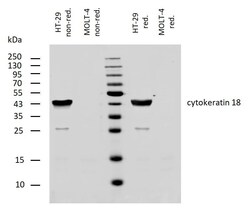
- Experimental details
- Western blotting analysis of human cytokeratin 18 using mouse monoclonal antibody DC-10 on lysates of HT-29 cell line and MOLT-4 cell line (cytokeratin non-expressing cell line; negative control) under non-reducing and reducing conditions. Nitrocellulose membrane was probed with 2µg/mL of mouse anti-cytokeratin 18 Monoclonal antibody (Product # MA1-19041) followed by IRDye800-conjugated anti-mouse secondary antibody. A specific band was detected for cytokeratin 18 at approximately 46kDa, and its proteolytic fragment at approximately 25 kDa.
- Submitted by
- Invitrogen Antibodies (provider)
- Main image
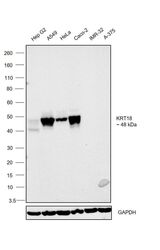
- Experimental details
- Western blot was performed using Anti-Cytokeratin 18 Monoclonal Antibody (DC-10)(Product # MA1-19041) and a 48kDa band corresponding to Cytokeratin 18 was observed across the cell lines tested except IMR-32 and A-375. Whole cell extracts (30 µg lysate) of Hep G2 (Lane 1), A549 (Lane 2), HeLa (Lane 3), Caco-2 (Lane 4), IMR-32 (Lane 5) and A-375 (Lane 6) were electrophoresed using NuPAGE™ 4-12% Bis-Tris Protein Gel (Product # NP0321BOX). Resolved proteins were then transferred onto a Nitrocellulose membrane (Product # LC2001) by iBlot® 2 Dry Blotting System (Product # IB21001). The blot was probed with the primary antibody (1ug/ml) and detected by chemiluminescence with Goat anti-Mouse IgG (H+L) Superclonal™ Recombinant Secondary Antibody, HRP (Product # A28177,1:4000 dilution) using the iBright FL 1000 (Product # A32752). Chemiluminescent detection was performed using Novex® ECL Chemiluminescent Substrate Reagent Kit (Product # WP20005).
Supportive validation
- Submitted by
- Invitrogen Antibodies (provider)
- Main image
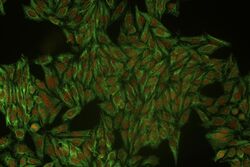
- Experimental details
- Immunocytochemistry staining of cytokeratin 18 in Hep-2 cells using mouse Monoclonal antibody DC-10 (Product # MA1-19041) using a dilution of 1:400, detected with GAM IgG-Alexa Fluor®488 (diluted 1:200; green), cell nuclei stained with PI (1 µg/mL; orange).
- Submitted by
- Invitrogen Antibodies (provider)
- Main image
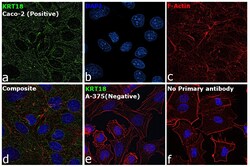
- Experimental details
- Immunofluorescence analysis of Cytokeratin 18 was performed using 70% confluent log phase Caco-2 cells. The cells were fixed with ice-cold acetone at 4°C for 5 minutes and blocked with 2% BSA for 45 minutes at room temperature. The cells were labeled with Cytokeratin 18 Monoclonal Antibody (DC-10) (Product # MA1-19041) at a concentration of 5 µg/mL in 0.1% BSA, incubated at 4 degree celsius overnight and then labeled with Goat anti-Mouse IgG (H+L) Superclonal™ Recombinant Secondary Antibody, Alexa Fluor® 488 conjugate (Product # A28175), (1:2000 dilution), for 45 minutes at room temperature (Panel a: Green). Nuclei (Panel b: Blue) were stained with SlowFade® Gold Antifade Mountant with DAPI (Product # S36938). F-actin (Panel c: Red) was stained with Rhodamine Phalloidin (Product # R415,1:300 dilution). Panel d represents the merged image showing cytoskeletal localization. Panel e represents A-375 cells with lack cytoskeletal staining. Panel f represents control cells with no primary antibody to assess background. The images were captured at 60X magnification.
- Submitted by
- Invitrogen Antibodies (provider)
- Main image
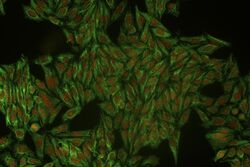
- Experimental details
- Immunocytochemistry analysis of Cytokeratin 18 using Cytokeratin 18 Monoclonal Antibody (DC-10) (Product # MA1-19041) at a dilution of 1:400 in Hep-2 cells.
- Submitted by
- Invitrogen Antibodies (provider)
- Main image
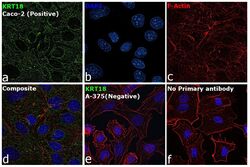
- Experimental details
- Immunofluorescence analysis of Cytokeratin 18 was performed using 70% confluent log phase Caco-2 cells. The cells were fixed with ice-cold acetone at 4°C for 5 minutes and blocked with 2% BSA for 45 minutes at room temperature. The cells were labeled with Cytokeratin 18 Monoclonal Antibody (DC-10) (Product # MA1-19041) at a concentration of 5 µg/mL in 0.1% BSA, incubated at 4 degree celsius overnight and then labeled with Goat anti-Mouse IgG (H+L) Superclonal™ Recombinant Secondary Antibody, Alexa Fluor® 488 conjugate (Product # A28175), (1:2000 dilution), for 45 minutes at room temperature (Panel a: Green). Nuclei (Panel b: Blue) were stained with SlowFade® Gold Antifade Mountant with DAPI (Product # S36938). F-actin (Panel c: Red) was stained with Rhodamine Phalloidin (Product # R415,1:300 dilution). Panel d represents the merged image showing cytoskeletal localization. Panel e represents A-375 cells with lack cytoskeletal staining. Panel f represents control cells with no primary antibody to assess background. The images were captured at 60X magnification.
Supportive validation
- Submitted by
- Invitrogen Antibodies (provider)
- Main image
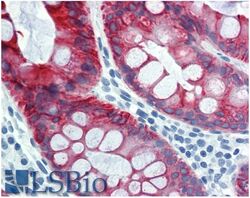
- Experimental details
- Immunohistochemistry staining of human colon (paraffin sections) using anti-cytokeratin 18 (clone DC-10) Monoclonal antibody (Product # MA1-19041).
Supportive validation
- Submitted by
- Invitrogen Antibodies (provider)
- Main image
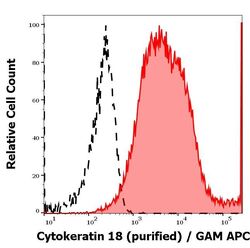
- Experimental details
- Separation of MCF-7 cells (red-filled) from Caco-2 cells (black-dashed) in flow cytometry analysis (intracellular staining) of cells stained using anti-cytokeratin 18 (DC-10) purified Monoclonal antibody (Product # MA1-19041) (concentration in sample 0.6 µg/mL, GAM APC).
- Submitted by
- Invitrogen Antibodies (provider)
- Main image
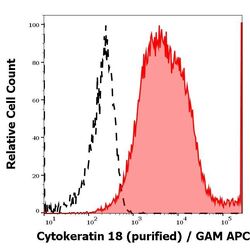
- Experimental details
- Separation of MCF-7 cells (red-filled) from Caco-2 cells (black-dashed) in flow cytometry analysis (intracellular staining) of cells stained using anti-cytokeratin 18 (DC-10) purified Monoclonal antibody (Product # MA1-19041) (concentration in sample 0.6 µg/mL, GAM APC).
 Explore
Explore Validate
Validate Learn
Learn Western blot
Western blot ELISA
ELISA